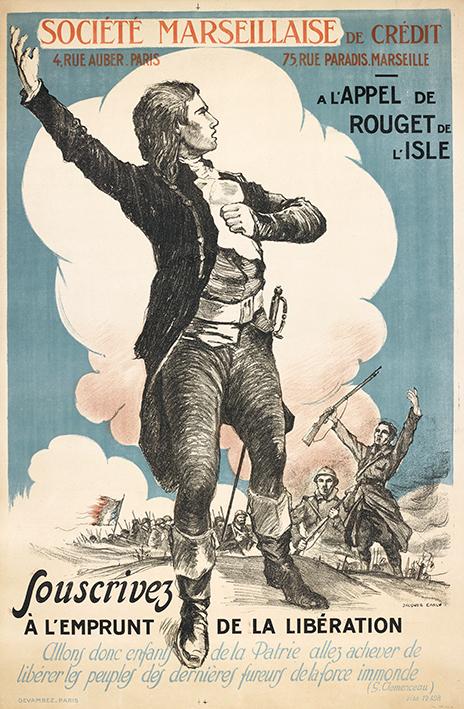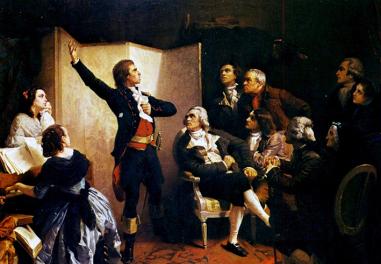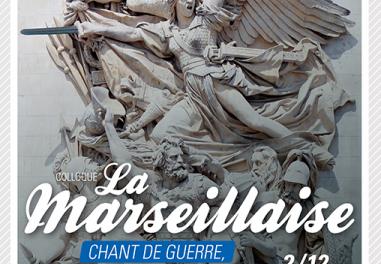Rouget de Lisle and La Marseillaise
Designed and produced by the Musée de l'Armée as part of “2016, the year of La Marseillaise”, this documentary exhibition, shown in the main courtyard of the Hôtel des Invalides until October, has since become a touring exhibition, also accessible via the museum's website.

In 2016, declared “Year of La Marseillaise” by the French President, as part of commemorations of the 180th anniversary of Rouget de Lisle's death in 1836, the Musée de l'Armée designed and produced a documentary exhibition entitled “Rouget de Lisle and La Marseillaise”. The exhibition is part of the cultural, scientific and educational season around La Marseillaise, organised in partnership with the Ministry of Defence and the Ministry of National Education, Higher Education and Research.
Consisting of 22 panels distributed around the galleries of the main courtyard of the Hôtel des Invalides, the exhibition retraced the history of the anthem, from the declaration of war on Austria, in 1792, to the present day. As with all of the museum's documentary exhibitions, it is permanently accessible in the form of a virtual exhibition.
Written by Rouget de Lisle, the Chant de guerre pour l'Armée du Rhin (Battle song for the Army of the Rhine), subsequently renamed La Marseillaise, had a changing status. It began life as a fighting song, which fellow composer and friend André Grétry described as “rousing battle music”. On 28 September 1792, on the proposal of war minister Joseph Servan, La Marche des Marseillois became the anthem of the combatant Republic. Then, on 24 November 1793, La Marseillaise was declared the official anthem by the Montagnard Convention. Finally, it was adopted as the French national anthem, in 1879, under the Third Republic.
Each panel is illustrated with a main image - a score, poster, object or photograph. The exhibition is based around two main themes: how La Marseillaise and Rouget de Lisle have been portrayed in different periods, and how those portrayals were “intensively” used during the First World War. It also looks at the figure and military career of Rouget de Lisle, military music and revolutionary songs, arrangements for orchestra, as well as the performances of La Marseillaise given during the Second World War, right up to the one given last year as a tribute to the victims of the Paris attacks. Use your phone to scan the QR codes on some panels, to add an additional audio or audiovisual dimension to your tour.
To produce this exhibition, the Musée de l'Armée drew on its documentary resources and collections. A number of partner institutions also contributed documents from their collections: the Établissement de Communication et de Production Audiovisuelle de la Défense (ECPAD), the Service Historique de la Défense (SHD), Paris Ouest Nanterre La Défense University's Library of Contemporary International Documentation (BDIC), the Choisy-le-Roi Archive, Documentation and Heritage Service, the Rouget de Lisle Museum in Lons-le-Saunier, and the Strasbourg Museums Documentation and Photo Library.
A partnership with the National Office for Veterans and War Victims (ONAC-VG) has made it possible to turn this into a touring exhibition. Since September 2016, it has been presented in a number of locations across France, and it will continue to cater to demand around the country for a number of years to come. Local authorities, schools and organisations can request the exhibition by contacting the ONAC-VG's departmental offices in Paris, Marseille, Strasbourg or Lons-le-Saunier, or its offices in the regional capitals, by consulting the ONAC-VG website.
Read more
Find the exhibition :
On the Musée de l'Armée website : www.musee-armee.fr
On the ONAC-VG website : www.onac-vg.fr
Articles of the review
-
The file

La Marseillaise, past and present
Inherited from the French Revolution, La Marseillaise has been a part of French history for more than two centuries, both in times of hope and jubilation, and at its most tragic times of hardship and upheaval. A symbol of unity, it became the rallying cry of the champions of freedom, in France and a...Read more -
The event

“La Marseillaise: a song of war, a song of freedom”
The anniversary year of La Marseillaise is brought to a close on 2 December 2016 with a conference at the Ministry of Defence. This scientific event, bringing together researchers from France and overseas, is an opportunity to look, from a historical as well as a musicological perspective, at the Fr...Read more -
The interview

Aurore Tillac
The official choir of the French Republic, the choir of the Republican Guard is formed of 45 French singers, recruited from among the elite of the discipline. Director of the choir since 2007, Aurore Tillac talks of the special place of La Marseillaise in the official repertoire....Read more

